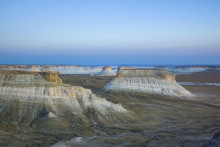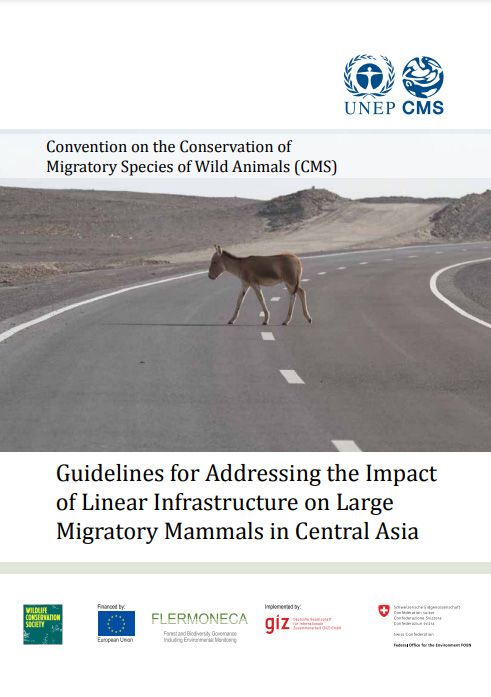In the tri-border area between Kazakhstan, Uzbekistan, and Turkmenistan lies the Ustyurt Plateau, characterised by canyons and different types of deserts. It is one of the last places of refuge for various species of animals listed on the Appendices of the Convention on the Conservation of Migratory Species of Wild Animals (CMS), an environmental treaty of the United Nations. Some of these migratory species are endangered and endemic, and include Saiga Antelopes (Saiga tatarica), Urial (Ovis vignei), Goitered Gazelles (Gazella subgutturosa), Kulan (Equus hemionus), and Persian Leopards (Panthera pardus tulliana).
Gazella subgutturosa
 The Goitered or black-tailed gazelle (Gazella subgutturrosa) has a wide distribution range, covering about 20 countries, in the Arabian Peninsula across the Middle East and Asia to Kazakhstan, Mongolia, China and Pakistan. Goitered gazelles are found in arid deserts and desert-steppe habitats. The body length of the animal is about 90-115 cm, while their shoulder height is 60-80 cm and an adult gazelle weighs around 18 - 33 kg. The light brown body of the Goitered gazelle darkens towards the belly, where it joins with the white under parts in a crisp line. The tail, 15-20 cm long, is black in colour, giving them their other name: black-tailed gazelle. Only male Goitered gazelles have horns, which grow 25-43 cm long. In summer small family groups of 2-5 animals are formed, while in winter large herds with dozens or even hundreds of individuals are the norm.
The Goitered or black-tailed gazelle (Gazella subgutturrosa) has a wide distribution range, covering about 20 countries, in the Arabian Peninsula across the Middle East and Asia to Kazakhstan, Mongolia, China and Pakistan. Goitered gazelles are found in arid deserts and desert-steppe habitats. The body length of the animal is about 90-115 cm, while their shoulder height is 60-80 cm and an adult gazelle weighs around 18 - 33 kg. The light brown body of the Goitered gazelle darkens towards the belly, where it joins with the white under parts in a crisp line. The tail, 15-20 cm long, is black in colour, giving them their other name: black-tailed gazelle. Only male Goitered gazelles have horns, which grow 25-43 cm long. In summer small family groups of 2-5 animals are formed, while in winter large herds with dozens or even hundreds of individuals are the norm.
The Goitered gazelle moves seasonally and can cover up to 30 km per day in the wintertime. In the summertime the distance they travel is substantially shorter. The gazelle can run at speeds of up to 60 km/h. The basic habitat requirements are the availability of water, shallow snow cover in winter and broken terrain (low basins and hollows that stay snow-free), or vegetation as cover. The recent estimates suggest that the population number is about 120,000 – 140,000 animals with the largest share in Mongolia (around 40% – 60% of the global population).
The numbers of Goitered gazelle have decreased significantly over the last decade. The key threats include illegal hunting and habitat loss. The last one is a result of the expanding infrastructure development, agricultural conversion, and increasing livestock numbers across the species’ range. In Mongolia heavy poaching has wiped out almost all the large herds and cut the numbers by almost 50%. The population in Turkmenistan has almost disappeared in recent years due to illegal hunting.
Photo Credit: Petra Kaczensky
Conservation:
The species is listed in the CMS Appendix II. It is recommended for cooperative action (rapid measures to assist the conservation of species listed under Appendix II) by Resolution 11.13 of the CMS COP11. The Goitered gazelle is covered under the Central Asian Mammals Initiative and its Programme of Work (POW) adopted in 2014. The key activities of the POW addressing the Goitered gazelle conservation are related to the mitigation of the effects of linear infrastructure on their habitat. The CMS Infrastructure Guidelines also seeks to provide solutions for mitigating impacts from linear infrastructure on several Central Asian migratory mammals. The species is included in the IUCN Red Book as vulnerable.
Описание:
Джейран (Gazella subgutturrosa) имеет обширный ареал обитания, охватывающий около 20 стран на Аравийском полуострове, Ближнем Востоке и в Азии, а именно в Казахстане, Монголии, Китае и Пакистане. Джейраны обитают в засушливых пустынях и полупустынях. Длина тела этого животного составляет от 90 до 115 см, а высота в холке от 60 до 80 см. Взрослая газель этого вида весит порядка 18 - 33 кг. Светло-коричневый окрас шкуры джейрана темнеет животу, где он соединяется с белым подшерстком. Хвост, длинной примерно 20 см, имеет черный окрас, отсюда происходит другое название этого вида – черно-хвостая газель. Только самцы джейранов имеют рога, которые достигают в длину порядка 25-43 см. Летом джейраны обитают небольшими группами от 2 до 5 голов, а зимой формируют большие стада, которые включают десятки и даже сотни голов.
Джейран мигрирует сезонно и может передвигаться на расстояние до 30 км в день. В летнее время они передвигаются на более короткие расстояния. Джейран может передвигаться со скоростью до 60 км/ч. Джейраны предпочитают места обитания с наличием источника воды, неглубоким снежным покровом в зимний период и пересеченной местностью с пологими участками, которые остаются не покрыты снегом. В летний период наличие густой растительности является условием. По последним оценкам численность популяции джейранов составляет около 120,000 – 140,000 животных и наибольшая популяция обитает в Монголии (около 40% – 60% от общей численности).
Популяция джейрана значительно снизилась за последнее десятилетие. Ключевыми угрозами являются незаконная охота и потеря мест обитания. Последнее связано с развитием инфраструктуры, перевода земель в сельскохозяйственные угодия и увеличение поголовий домашнего скота по всему ареалу распространения джейрана. В Монголии по разным подсчетами браконьерство могло сократить популяции джейранов на 50%. Популяция в Туркменистане почти исчезла в последние годы в связи с незаконной охотой.
Фото предоставлено: Petra Kaczensky
Сохранение джейрана:
Джейран включен в Приложении II КМВ. Он рекомендован для совместных действий (оперативных мер, по сохранению видов, перечисленных в Приложении IIстранами ареала) в соответствии с Резолюцией 11.13, принятой на 11-ой Встречи сторон КМВ. Он также включен в Центрально-Азиатскую Инициативу по Млекопитающим (ЦАИМ) и Программу Работы ЦАИМ, принятых в 2014 году. Основные рекомендации Программы работы по сохранению джейрана включают смягчение последствий от линейной инфраструктуры на места обитания джейрана. Принятое Руководство по инфраструктуре КМВ также предлагает решения для смягчения последствий от линейной инфраструктуры на разные виды мигрирующих животных Центральной Азии. Этот вид занесен в Красную Книгу МСОП, как уязвимый.
| CMS Instruments | CMS, Central Asian Mammals Initiative |
|---|---|
| IUCN Status | Vulnerable |
| Date of entry in Appendix II | 2002 |
| Countries | Afghanistan, Armenia, Azerbaijan, China, Georgia, Iran, Iraq, Kazakhstan, Kyrgyzstan, Pakistan, Syrian Arab Republic, Tajikistan, Turkmenistan, Türkiye, Uzbekistan |
|---|
No pictures for Gazella subgutturosa
| English | Goitered Or Black-Tailed Gazelle |
|---|---|
| French | Gazelle Á Goitre |
| German | Kropfgazelle, persische gazelle |
| Class | Mammalia |
|---|---|
| Order | Artiodactyla |
| Family | Bovidae |
| Scientific name | Gazella subgutturosa |
Current Focus
E-Newsletter: CAMI Newsletter April 2023
Publication: Guidelines for Addressing the Impact of Linear Infrastructure on Large Migratory Mammals in Central Asia









